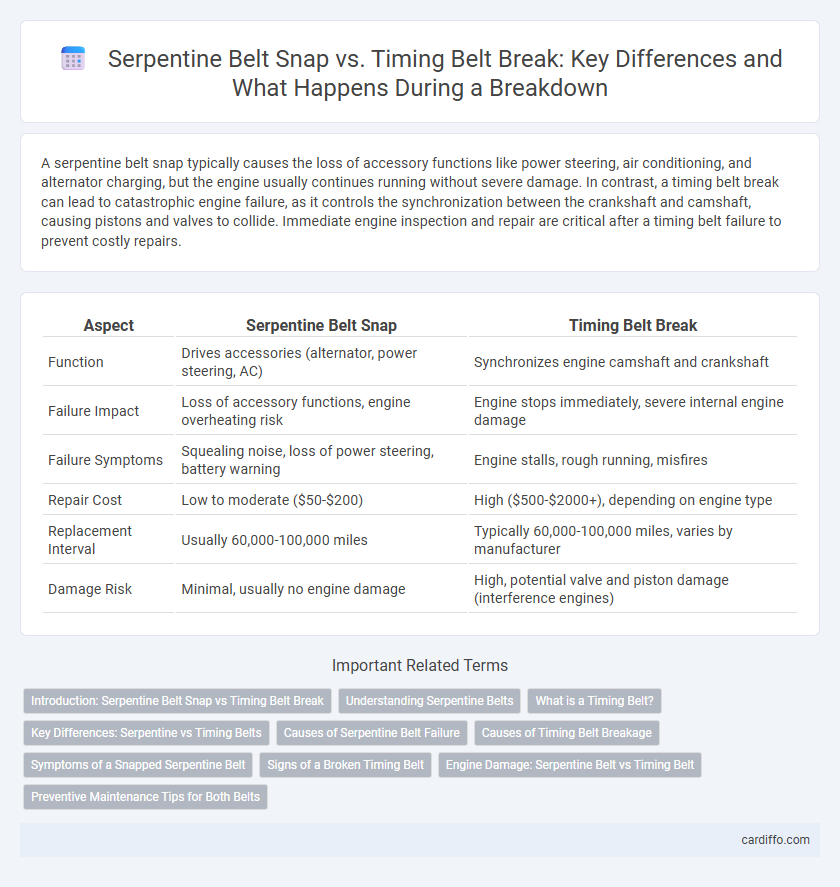A serpentine belt snap typically causes the loss of accessory functions like power steering, air conditioning, and alternator charging, but the engine usually continues running without severe damage. In contrast, a timing belt break can lead to catastrophic engine failure, as it controls the synchronization between the crankshaft and camshaft, causing pistons and valves to collide. Immediate engine inspection and repair are critical after a timing belt failure to prevent costly repairs.
Table of Comparison
| Aspect | Serpentine Belt Snap | Timing Belt Break |
|---|---|---|
| Function | Drives accessories (alternator, power steering, AC) | Synchronizes engine camshaft and crankshaft |
| Failure Impact | Loss of accessory functions, engine overheating risk | Engine stops immediately, severe internal engine damage |
| Failure Symptoms | Squealing noise, loss of power steering, battery warning | Engine stalls, rough running, misfires |
| Repair Cost | Low to moderate ($50-$200) | High ($500-$2000+), depending on engine type |
| Replacement Interval | Usually 60,000-100,000 miles | Typically 60,000-100,000 miles, varies by manufacturer |
| Damage Risk | Minimal, usually no engine damage | High, potential valve and piston damage (interference engines) |
Introduction: Serpentine Belt Snap vs Timing Belt Break
Serpentine belt snap typically results in loss of power steering, alternator function, and air conditioning, causing immediate convenience issues but generally allowing the engine to run. Timing belt break, however, leads to catastrophic engine damage as it disrupts synchronization between the crankshaft and camshaft, potentially causing piston and valve collision. Understanding the distinct functions and consequences of these belt failures is critical for timely diagnosis and prevention of costly repairs.
Understanding Serpentine Belts
Serpentine belts are crucial for powering multiple engine components like the alternator, power steering pump, and air conditioning compressor. Unlike timing belts, serpentine belts are easier and less costly to replace, with wear signs including cracking, fraying, and glazing. A serpentine belt snap usually results in accessory failure and engine overheating, but rarely causes severe engine damage compared to a timing belt break, which can lead to major engine repair.
What is a Timing Belt?
A timing belt is a crucial component in an internal combustion engine that synchronizes the rotation of the crankshaft and camshaft, ensuring precise timing of engine valves. Unlike the serpentine belt, which drives multiple peripheral devices, the timing belt operates inside the engine and is made of reinforced rubber with teeth to prevent slipping. Failure of the timing belt often leads to severe engine damage, as it can cause valves to collide with pistons, necessitating timely inspection and replacement to avoid costly repairs.
Key Differences: Serpentine vs Timing Belts
A snapped serpentine belt typically causes the loss of auxiliary functions like power steering, alternator charging, and air conditioning, resulting in immediate but manageable breakdown symptoms. In contrast, a timing belt break can lead to severe engine damage by causing the pistons and valves to collide, often requiring costly repairs or engine replacement. Understanding these key differences helps prioritize timely maintenance and avoid catastrophic engine failure.
Causes of Serpentine Belt Failure
Serpentine belt failure primarily results from wear and tear due to prolonged use, exposure to heat, and contamination from oil or coolant leaks. Common causes include misaligned pulleys, damaged tensioners, and cracked or glazed belt surfaces, which reduce grip and increase the risk of snapping. Unlike timing belts, serpentine belts operate auxiliary components and their failure can lead to power steering loss, alternator malfunction, and overheating.
Causes of Timing Belt Breakage
Timing belt breakage is primarily caused by wear and tear, oil contamination, or improper installation, which weakens the belt material and leads to sudden failure. Unlike serpentine belts that power multiple accessories, timing belts synchronize the engine's camshaft and crankshaft, so breakage often results in severe engine damage. Regular inspection and timely replacement according to manufacturer specifications help prevent premature timing belt failure.
Symptoms of a Snapped Serpentine Belt
A snapped serpentine belt causes immediate loss of power steering, alternator function, and air conditioning, often accompanied by a loud squealing noise at the moment of failure. Engine overheating may occur rapidly due to the water pump ceasing to operate, leading to dashboard warning lights such as the battery and temperature indicators. Unlike a timing belt break, serpentine belt failure typically does not result in severe engine damage but requires prompt replacement to restore vehicle functionality.
Signs of a Broken Timing Belt
A broken timing belt often causes the engine to stop running abruptly, accompanied by a noticeable loss of power and rough idling. Symptoms include unusual engine noises such as ticking or knocking, difficulty starting the car, and the illumination of the check engine light. Unlike a serpentine belt snap, a timing belt break can result in severe engine damage, making immediate inspection and repair critical.
Engine Damage: Serpentine Belt vs Timing Belt
A serpentine belt snap usually results in loss of power steering, alternator, and air conditioning but rarely causes engine damage as it drives peripheral components. In contrast, a timing belt break often leads to severe engine damage, including bent valves, piston damage, and potential engine failure, since it synchronizes the camshaft and crankshaft. Prompt replacement and inspection of the timing belt at manufacturer-recommended intervals are crucial to prevent costly engine repairs.
Preventive Maintenance Tips for Both Belts
Serpentine belt snap and timing belt break both cause severe engine damage but differ in failure symptoms and consequences. Regular inspection every 30,000 miles for cracks, fraying, or glazing and timely replacement of the serpentine belt around 60,000-100,000 miles can prevent unexpected breakdowns. Timing belt replacement should strictly follow manufacturer intervals, typically between 60,000 and 100,000 miles, with additional checks for tensioner and pulley wear to avoid catastrophic engine failure.
Serpentine belt snap vs timing belt break Infographic

 cardiffo.com
cardiffo.com